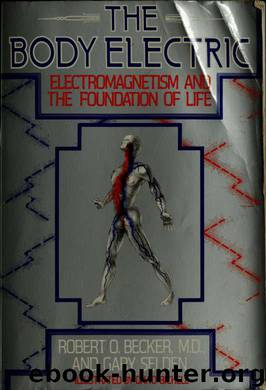The body electric : electromagnetism and the foundation of life by Becker Robert O;Selden Gary & Selden Gary

Author:Becker, Robert O;Selden, Gary & Selden, Gary
Language: eng
Format: epub
Tags: Electromagnetism, Electromagnetism in medicine
Publisher: New York : Quill
Published: 1985-02-18T16:00:00+00:00
point of inhibiting seizures, the random spread of impulses in the brain. They may also have an important part in memory, and they probably conduct the direct currents so important to regeneration. They're essential to healing wherever it occurs in nerve tissue.
Peripheral Nerves
Peripheral nerve fibers can regrow—otherwise we'd lose sensation whenever we cut a finger—but neurons and their fibers in the CNS cannot. The peripheral nerve's cell body survives, safe in the cord or brain, and the cut end of the attached part of the fiber is sealed off. The outer, severed part dies and degenerates; some of its Schwann cells digest it, along with the now-useless myelinated membrane layers. The empty Schwann tube remains, however, and begins to grow toward the proximal fiber (the one nearer the center of the body), whose Schwann cells are also growing across the chasm. When these cells meet, the nerve fiber grows along its reconnected sheath and eventually makes contact with the same terminals it originally served.
In salamanders this process is very efficient. The Schwann cells can cross large gaps, and an experimenter who wishes to work with dener-vated limbs must be diligent to keep the nerves from reentering. In humans, the two ends of the tube usually can't find each other over a distance of more than a centimeter. In that case the proximal sheath with its intact nerve fiber hunts for its opposite number by growing in an ever increasing spiral, apparently searching for some signal from the distal end (the part farther from the body center). Since each nerve is formed of many fibers, these spiraling tubes entangle each other in a lump of nerve tissue called a neuroma. Neuromas are painfully sensitive and often must be cut away. Occasionally a surgeon can move the two ends of the nerve close enough for the Schwann cells to make contact. If that's impossible, the gap may be closed with a piece of nerve grafted from a less important peripheral nerve that can be sacrificed. Unfortunately, nerve grafts don't take reliably, and other methods, such as making artificial channels with tiny plastic tubules, are still in the experimental stage.
We don't know why the salamander's peripheral nerve regrowth is so much more effective than ours, but I surmise that its more efficient DC electrical system accounts for the difference. If the locator signal is electrical, it should be possible to augment it in humans so as to grow nerve fibers over longer distances. Beginning with a 1974 report from David
Download
This site does not store any files on its server. We only index and link to content provided by other sites. Please contact the content providers to delete copyright contents if any and email us, we'll remove relevant links or contents immediately.
| Cell Biology | Developmental Biology |
| Entomology | Marine Biology |
| Microbiology | Molecular Biology |
| Biostatistics |
Sapiens: A Brief History of Humankind by Yuval Noah Harari(13048)
The Tidewater Tales by John Barth(12029)
Do No Harm Stories of Life, Death and Brain Surgery by Henry Marsh(6335)
Mastermind: How to Think Like Sherlock Holmes by Maria Konnikova(6234)
The Thirst by Nesbo Jo(5783)
Why We Sleep: Unlocking the Power of Sleep and Dreams by Matthew Walker(5639)
Sapiens by Yuval Noah Harari(4534)
Life 3.0: Being Human in the Age of Artificial Intelligence by Tegmark Max(4502)
The Longevity Diet by Valter Longo(4445)
The Rules Do Not Apply by Ariel Levy(3905)
The Immortal Life of Henrietta Lacks by Rebecca Skloot(3826)
The Body: A Guide for Occupants by Bill Bryson(3797)
Why We Sleep by Matthew Walker(3771)
Animal Frequency by Melissa Alvarez(3754)
Yoga Anatomy by Kaminoff Leslie(3700)
Barron's AP Biology by Goldberg M.S. Deborah T(3631)
The Hacking of the American Mind by Robert H. Lustig(3579)
All Creatures Great and Small by James Herriot(3514)
Yoga Anatomy by Leslie Kaminoff & Amy Matthews(3394)
